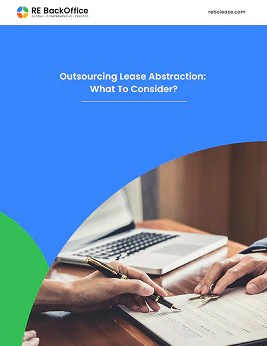
In the realm of leasing, supporting lease documents act as the cornerstone of a successful and mutually beneficial agreement between lessors and lessees. These documents serve as the blueprint for the leasing arrangement, outlining the terms, conditions, and responsibilities of both parties involved. From commercial spaces to residential properties, the importance of supporting lease documents cannot be overstated, as they provide clarity, protection, and assurance throughout the duration of the lease.
In the intricate world of real estate leasing, understanding the array of documents involved is crucial for both landlords and tenants. From lease abstraction to lease administration and CAM (Common Area Maintenance) reconciliation, each document plays a pivotal role in shaping the terms and conditions of a lease agreement. These documents serve as the roadmap for the leasing journey, delineating rights, responsibilities, and expectations for all parties involved.
In this comprehensive guide, we delve into the key documents, including amendments, addendums, riders, exhibits, insurance certificates, and guarantee agreements, shedding light on their significance and how they contribute to the leasing process.
Amendments
Amendments in lease agreements offer a flexible mechanism for adjusting various terms and conditions without the need to entirely rewrite the original lease document. This flexibility is crucial as circumstances can change during the lease term, necessitating modifications to better suit the evolving needs of both the landlord and the tenant.
When parties decide to modify certain aspects of the lease agreement, such as extending the lease term, changing rent amounts, or updating other provisions, they can do so through the execution of an amendment. This separate document, often referred to as a lease amendment or modification agreement, serves as a legal record of the agreed-upon changes. Rather than drafting an entirely new lease agreement, which can be time-consuming and cumbersome, parties can use amendments to make targeted adjustments efficiently.
For example, imagine a scenario where a tenant wishes to extend their lease beyond the original term, or perhaps the landlord wants to adjust the rent due to fluctuations in the real estate market. Rather than renegotiating the entire lease from scratch, the parties can execute a lease amendment to formally document the agreed-upon changes. This could involve appending additional terms to the existing lease or modifying specific clauses to reflect the new arrangements.
The timing of amendments can vary depending on the circumstances. They may be initiated at any point during the lease term, whether it's shortly after signing the original lease or years into the agreement. For instance, if adjustments become necessary three years into a five-year lease term, the parties can execute a first amendment to reflect the changes agreed upon by both parties. This ensures transparency and legal clarity regarding the updated terms and conditions of the lease.
In essence, amendments provide a practical solution for addressing changes and evolving requirements within the lease agreement while maintaining the integrity of the original contract. By formalizing alterations through amendments, landlords and tenants can navigate adjustments smoothly while minimizing potential disputes or misunderstandings.
Addendums and Riders
Addendums and riders play a crucial role in tailoring lease agreements to meet the specific needs and preferences of landlords and tenants.
Addendums:
- Addendums are formal documents that add new terms, conditions, or clauses to an existing lease agreement.
- They are used when significant modifications or additional provisions are required, such as changes in rent, lease duration, or responsibilities of either party.
- Addendums are typically drafted after the initial lease agreement is signed but before the lease term begins.
- Common addendums include pet policies, parking arrangements, maintenance responsibilities, and any other specific agreements negotiated between the landlord and tenant.
- Both parties must agree to and sign the addendum for it to become legally binding.
Riders:
- Riders are similar to addendums but typically involve minor modifications or clarifications to the existing lease terms.
- Unlike addendums, riders are often prepared and signed simultaneously with the original lease agreement.
- They are used for small adjustments or special requests that don't warrant a separate document but still require formal acknowledgment.
- Riders can address issues such as appliances included in the rental, alterations or improvements to the property, or specific rules regarding noise or use of common areas.
- While riders may not fundamentally alter the lease agreement, they provide a mechanism for both parties to customize certain aspects to better suit their needs.
In essence, addendums and riders serve as tools for landlords and tenants to customize lease agreements according to their unique circumstances. Whether it's accommodating special requests, clarifying terms, or incorporating additional provisions, these supplementary documents contribute to creating a more flexible and collaborative leasing environment. Both parties should carefully review and negotiate any proposed addendums or riders to ensure they accurately reflect their agreements and protect their interests.
Exhibits
Exhibits within lease agreements serve the crucial function of detailing the specifications of the leased premises, providing clarity and structure for both landlords and tenants. These exhibits typically include floor plans, signage specifications, and rules and regulations governing property usage.
Floor plans are a fundamental component of exhibits, offering a visual representation of the layout of the leased premises. They outline the dimensions and configurations of various spaces within the property, helping both parties understand the spatial arrangement and potential uses of the space.
Signage specifications, another key aspect of exhibits, detail the requirements for any signage associated with the property. This includes information on the location, size, design, and installation of signage, ensuring that tenants comply with the property's branding standards and local regulations.
Additionally, rules and regulations are often presented as a separate exhibit within the lease agreement. These documents outline the guidelines governing tenant conduct and property usage, covering topics such as noise restrictions, maintenance responsibilities, and access to common areas. By clearly delineating these expectations, rules and regulations exhibits promote transparency and help prevent misunderstandings between landlords and tenants.
In summary, exhibits play a vital role in lease agreements by providing detailed specifications of the leased premises. Through floor plans, signage specifications, and rules and regulations exhibits, landlords and tenants can establish clear expectations and guidelines for the use and management of the property. Thoroughly reviewing and understanding these exhibits is essential for ensuring a smooth and mutually beneficial leasing experience.
Insurance Certificates
Insurance certificates play a crucial role in lease agreements by providing tangible evidence of the tenant's insurance coverage, which is vital for safeguarding against unforeseen liabilities and risks. These certificates serve as a form of documentation that demonstrates the tenant's compliance with insurance obligations outlined in the lease agreement.
For landlords, requiring tenants to furnish insurance certificates is a proactive measure to mitigate potential financial losses. In the event of property damage, accidents, or other unforeseen incidents, having adequate insurance coverage can help protect both parties from costly liabilities. By ensuring that tenants maintain appropriate insurance coverage, landlords can minimize their exposure to risk and maintain the financial stability of their properties.
Moreover, insurance certificates underscore the importance of risk management and liability protection in lease transactions. By clearly outlining insurance requirements in the lease agreement and enforcing compliance through insurance certificates, landlords promote a secure and stable leasing environment for all parties involved. This proactive approach to risk management helps mitigate uncertainties and fosters trust and confidence between landlords and tenants.
Guarantee Agreements
Guarantee Agreements are contractual arrangements in which a third party pledges to support the financial obligations of a tenant under a lease agreement. These agreements are particularly valuable in scenarios where the tenant may have limited financial standing or is a new entrant in the market. By providing landlords with an additional layer of security, guarantee agreements help mitigate the risk of payment defaults and reassure landlords regarding the tenant's ability to fulfill lease obligations.
For landlords, guarantee agreements serve as a means of enhancing confidence in the financial stability of the tenant. By enlisting a guarantor, landlords can minimize uncertainties associated with tenant solvency and payment reliability. This added assurance is especially valuable in competitive or uncertain market conditions, where landlords may be more cautious about entering into lease agreements with tenants with less established financial histories.
Moreover, guarantee agreements delineate the terms of the guarantee, including the duration and extent of the guarantor's liability. By clearly defining these terms, guarantee agreements help minimize financial uncertainties and provide clarity regarding the obligations of all parties involved. This clarity fosters transparency and trust in lease transactions, facilitating smoother negotiations and reducing the potential for disputes down the line.
In conclusion, lease abstraction, lease administration, and CAM reconciliation entail a myriad of documents that shape the dynamics of lease transactions. From amendments and addendums to exhibits and guarantee agreements, each document serves a distinct purpose in clarifying rights, obligations, and expectations of both landlords and tenants. By understanding the nuances of these documents and their implications, stakeholders can navigate the lease landscape with confidence, fostering mutually beneficial relationships and ensuring compliance with legal and contractual obligations. In essence, effective management of lease documents is essential for mitigating risks, promoting transparency, and facilitating smooth lease transactions in the ever-evolving real estate market.


